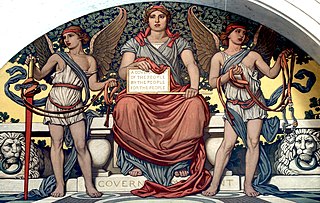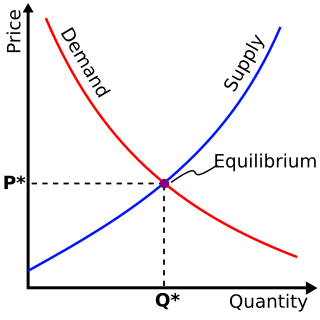Related Research Articles

Gross domestic product (GDP) is a monetary measure of the market value of all the final goods and services produced and rendered in a specific time period by a country or countries. GDP is often used to measure the economic health of a country or region. Several national and international economic organizations maintain definitions of GDP, such as the OECD and the International Monetary Fund.

Macroeconomics is a branch of economics that deals with the performance, structure, behavior, and decision-making of an economy as a whole. This includes regional, national, and global economies. Macroeconomists study topics such as output/GDP and national income, unemployment, price indices and inflation, consumption, saving, investment, energy, international trade, and international finance.
In economics, a recession is a business cycle contraction that occurs when there is a period of broad decline in economic activity. Recessions generally occur when there is a widespread drop in spending. This may be triggered by various events, such as a financial crisis, an external trade shock, an adverse supply shock, the bursting of an economic bubble, or a large-scale anthropogenic or natural disaster. There is no official definition of a recession, according to the IMF.

Monetarism is a school of thought in monetary economics that emphasizes the role of policy-makers in controlling the amount of money in circulation. It gained prominence in the 1970s but was mostly abandoned as a direct guidance to monetary policy during the following decade because of the rise of inflation targeting through movements of the official interest rate.

In economics and political science, fiscal policy is the use of government revenue collection and expenditure to influence a country's economy. The use of government revenue expenditures to influence macroeconomic variables developed in reaction to the Great Depression of the 1930s, when the previous laissez-faire approach to economic management became unworkable. Fiscal policy is based on the theories of the British economist John Maynard Keynes, whose Keynesian economics theorised that government changes in the levels of taxation and government spending influence aggregate demand and the level of economic activity. Fiscal and monetary policy are the key strategies used by a country's government and central bank to advance its economic objectives. The combination of these policies enables these authorities to target inflation and to increase employment. In modern economies, inflation is conventionally considered "healthy" in the range of 2%–3%. Additionally, it is designed to try to keep GDP growth at 2%–3% and the unemployment rate near the natural unemployment rate of 4%–5%. This implies that fiscal policy is used to stabilise the economy over the course of the business cycle.
Business cycles are intervals of general expansion followed by recession in economic performance. The changes in economic activity that characterize business cycles have important implications for the welfare of the general population, government institutions, and private sector firms.
In economics, the fiscal multiplier is the ratio of change in national income arising from a change in government spending. More generally, the exogenous spending multiplier is the ratio of change in national income arising from any autonomous change in spending. When this multiplier exceeds one, the enhanced effect on national income may be called the multiplier effect. The mechanism that can give rise to a multiplier effect is that an initial incremental amount of spending can lead to increased income and hence increased consumption spending, increasing income further and hence further increasing consumption, etc., resulting in an overall increase in national income greater than the initial incremental amount of spending. In other words, an initial change in aggregate demand may cause a change in aggregate output that is a multiple of the initial change.

The government budget balance, also referred to as the general government balance, public budget balance, or public fiscal balance, is the difference between government revenues and spending. For a government that uses accrual accounting the budget balance is calculated using only spending on current operations, with expenditure on new capital assets excluded. A positive balance is called a government budget surplus, and a negative balance is a government budget deficit. A government budget presents the government's proposed revenues and spending for a financial year.
The accelerator effect in economics is a positive effect on private fixed investment of the growth of the market economy. Rising GDP implies that businesses in general see rising profits, increased sales and cash flow, and greater use of existing capacity. This usually implies that profit expectations and business confidence rise, encouraging businesses to build more factories and other buildings and to install more machinery. This may lead to further growth of the economy through the stimulation of consumer incomes and purchases, i.e., via the multiplier effect.
The early 1990s recession describes the period of economic downturn affecting much of the Western world in the early 1990s. The impacts of the recession contributed in part to the 1992 U.S. presidential election victory of Bill Clinton over incumbent president George H. W. Bush. The recession also included the resignation of Canadian prime minister Brian Mulroney, the reduction of active companies by 15% and unemployment up to nearly 20% in Finland, civil disturbances in the United Kingdom and the growth of discount stores in the United States and beyond.
The Austrian business cycle theory (ABCT) is an economic theory developed by the Austrian School of economics seeking to explain how business cycles occur. The theory views business cycles as the consequence of excessive growth in bank credit due to artificially low interest rates set by a central bank or fractional reserve banks. The Austrian business cycle theory originated in the work of Austrian School economists Ludwig von Mises and Friedrich Hayek. Hayek won the Nobel Prize in Economics in 1974 in part for his work on this theory.
Advanced Placement (AP) Macroeconomics is an Advanced Placement macroeconomics course for high school students that culminates in an exam offered by the College Board.
Economic stability is the absence of excessive fluctuations in the macroeconomy. An economy with fairly constant output growth and low and stable inflation would be considered economically stable. An economy with frequent large recessions, a pronounced business cycle, very high or variable inflation, or frequent financial crises would be considered economically unstable.

The Great Moderation is a period of macroeconomic stability in the United States of America coinciding with the rise of independent central banking beginning from 1980 and continuing to the present day. It is characterized by generally milder business cycle fluctuations in developed nations, compared with decades before. Throughout this period, major economic variables such as real GDP growth, industrial production, unemployment, and price levels have become less volatile, while average inflation has fallen and recessions have become less common.

A global recession is a recession that affects many countries around the world—that is, a period of global economic slowdown or declining economic output.

The Depression of 1920–1921 was a sharp deflationary recession in the United States, United Kingdom and other countries, beginning 14 months after the end of World War I. It lasted from January 1920 to July 1921. The extent of the deflation was not only large, but large relative to the accompanying decline in real product.
Real business-cycle theory is a class of new classical macroeconomics models in which business-cycle fluctuations are accounted for by real, in contrast to nominal, shocks. RBC theory sees business cycle fluctuations as the efficient response to exogenous changes in the real economic environment. That is, the level of national output necessarily maximizes expected utility.

An economic recovery is the phase of the business cycle following a recession. The overall business outlook for an industry looks optimistic during the economic recovery phase.

This glossary of economics is a list of definitions containing terms and concepts used in economics, its sub-disciplines, and related fields.
References
- ↑ "Economic Growth: What It Is and How It Is Measured". Investopedia. 5 June 2024.
- ↑ Compare:Lederer, Emil (May 1939). "Is the Economic Frontier Closed?". Social Research . 6 (2). New York: 154–155. JSTOR 40981818.
I would define economic expansion as the increase of aggregate production from one production period to another. If the concept is defined in this general way it includes expansion that results from an increase in population, from better utilization [...].
- ↑ Ryan, Cillian; Mullineux, Andrew W. (1997). "The ups and downs of modern business cycle theory". In Snowdon, Brian; Vane, Howard R.; Backhouse, Roger E. (eds.). Reflections on the Development of Modern Macroeconomics. Cheltenham: Edward Elgar Publishing. p. 136. ISBN 978-1781008492 . Retrieved 22 May 2023.
[...] the primary focus of macroeconomics swung back from determining and manipulating the equilibrium level of output to the 'business cycle'.
- 1 2 "Economic Cycle: Definition and 4 Stages of the Business Cycle". Investopedia. 19 December 2023.
- ↑ Bondarenko, Peter. "expansion". Britannica Money.
- ↑ Claessens, Stijn; Kose, M. Ayhan (11 February 2019). "Recession: When Bad Times Prevail". International Monetary Fund.
- ↑ Colacito, Riccardo; Phan, Toan; Sablik, Tim (August 2018). "The Impact of Higher Temperatures on Economic Growth". Federal Reserve Bank of Richmond.
- ↑ Horton, Mark; El-Ganainy, Asmaa (28 June 2019). "Fiscal Policy: Taking and Giving Away". International Monetary Fund.
- ↑ "Regulatory reform". Organisation for Economic Co-operation and Development (OECD). Retrieved 25 January 2025.
- ↑ "Overview: World Economic Situation and Prospects 2024". United Nations. 5 January 2024.
- ↑ "Chapter 1. The economic impacts of the COVID-19 crisis". World Development Report (WDR). World Bank Group.
- ↑ Rodrigo, G. Chris (15 June 2017). "Micro and Macro: The Economic Divide". International Monetary Fund.